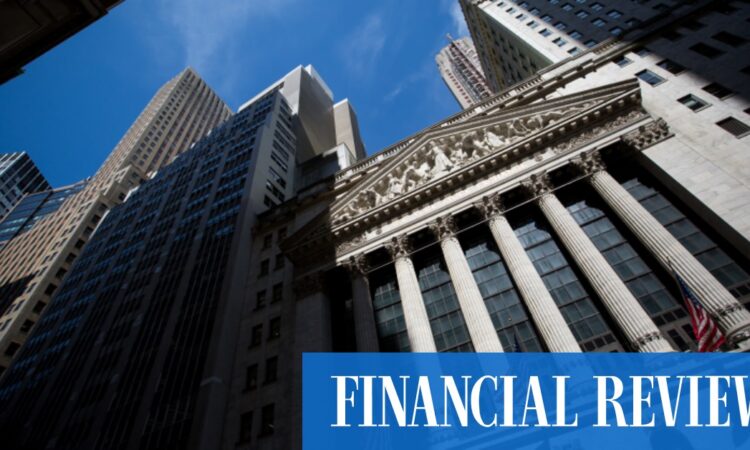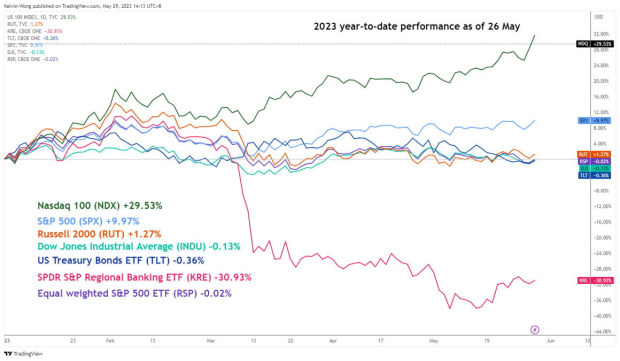
Mark Newton, head of technical strategy at Fundstrat Global, said the trend still bullish, the S&P 500 is expected to push up to 4235-4275, before consolidating somewhat. It closed at 4205 on Friday in New York.
“Given the divergences and near-term overbought conditions in technology, I’m inclined to view this ‘breakout’ above 4200 as having an above-average chance of proving false given the various breakdowns in other areas of the market.
“Yet, as a trend follower, I fail to see the point of continuing to mention poor breadth or overbought conditions as being a logical reason to avoid stock indices until they’ve demonstrated the ability to turn lower.”
Samy Chaar, chief economist at Lombard Odier: “Growth, particularly in the US, remains quite resilient. Inflation is pretty sticky. We’re back to the narrative where the Fed has to push harder to bring inflation down and that obviously is going to create some form of market anxiety because as you price rate hikes, rather than rate cuts, you put pressure on valuations.”
Fed officials scheduled to speak in the coming week include regional bank presidents Thomas Barkin of Richmond and Patrick Harker of Philadelphia, along with board member Philip Jefferson.
Today’s agenda
Local: Building approvals April 11.30am AEST; NZ April building permits at 8.45am AEST
Overseas data: Eurozone May consumer and economic confidence; US March FHFA house prices and S&P CoreLogic house prices; May consumer confidence index; May Dallas Fed index
Other stories
Mark McGowan’s shock exit is bad news for Anthony Albanese Western Australian Premier Mark McGowan has resigned near the height of his political power, in a shock move that makes it harder for federal Labor to maintain majority government at the next election.
PwC sends nine partners on leave, chairman exits The embattled firm will also “ringfence” all federal government advisory work as part of a suite of measures designed to signal it is taking decisive action.
What’s behind this year’s extraordinary rally in asset prices? The risk is that rising asset prices will put pressure on central bankers to tighten monetary policy to force people to change their attitudes, and behaviour, writes Karen Maley.
The RBA is taking Australia to a precipice Inflation is falling. There is no wage-price spiral. The central bank does not need to trigger a recession to contain them, writes Craig Emerson.
Market highlights
ASX down 8 points or 0.1% to 7229 near 5am AEST
- AUD +0.3% to 65.39 US cents
- Bitcoin +0.2% to $US27,677 at 5.17am AEST
- Wall St closed for Memorial Day
- Stoxx 50 -0.4% DAX -0.2% CAC -0.2%
- Spot gold -0.2% to $US1943.20/oz at 3.15pm in New York
- Brent crude +0.2% to $US77.07 a barrel
- Iron ore +2.7% to $US103.25 a tonne
- 10-year yield: US 3.80% Australia 3.70% Germany 2.43%
- US prices as of pm in New York
United States
Wall Street was closed. If the debt ceiling deal passes on Tuesday, attention will return to the U.S. Federal Reserve’s plans for rates. Markets are leaning towards expecting the Fed to raise rates by 25 basis points next month, then keep rates steady for the rest of the year.
Kelvin Wong, senior market analyst at OANDA: “The loop-sided ‘K-shaped’ performance has continued to persist in the US sharemarket since its October 2022 swing low. The Nasdaq 100 and S&P 500 are heavily weighted by the mega capitalisation technology stocks primarily the FAANG plus MNT group (Meta/Facebook, Apple, Amazon, Netflix, Alphabet/Google, Microsoft, NVIDIA & Tesla) have continued to outperform the rest (Dow & Russell 2000) by a wide margin.

“On the contrary, if we stripped out or normalised the weights of these mega cap technology stocks, the US sharemarket performance is just like a ‘speck of dust’ where the equal-weighted S&P 500 ETF has turned negative (-0.02 per cent) for the year.
“Therefore, if such a ‘K-shaped’ performance persists on the Nasdaq 100 and S&P 500, the odds are likely going to get higher for a downside correction to narrow the gap as a liquidity-tightening negative feedback loop can spiral easily into an increasingly weak US sharemarket breadth, a similar occurrence that was seen in March last year.”
Dan Suzuki, deputy chief investment officer at Richard Bernstein Advisors: “The obvious positive interpretation is that a negative tail risk is close to being taken off the table. With the distraction of the debt ceiling fading into the background, investors can now refocus their attention on the underlying fundamentals. One concern, though, is that the fundamental picture remains precarious.”
Admir Kolaj, economist at TD Economics: “The US housing market is showing signs of stabilising. Existing home inventories remain near multi-decade lows, in part because homeowners are reluctant to take on a new mortgage that comes with a financing rate that’s over 300 basis points above the average effective rate of existing mortgages. Supply conditions are a lot looser in the ‘new’ home segment. As such, this smaller corner of the housing market has been able to grab a slightly bigger share of overall sales.
“While mortgage rates are expected to drift lower over the coming year, there is some uncertainty over the medium term with respect to the economic outlook. If the labour market backdrop unfolds broadly as expected, home prices are likely to turn lower starting later this year, and could fall by as much as 5-7 per cent from peak.”
Commodities
Despite a recent rally, oil is about 10 per cent lower for the year as traders grapple with China’s lacklustre economy, aggressive interest-rate hikes from the Federal Reserve and concerns over the US debt ceiling.
That comes even after the Organisation of Petroleum Exporting Countries and its allies shocked markets in early April with an unexpected cut to production, which initially sent prices higher amid supply concerns.
OPEC+ members are scheduled to meet June 3-4 in Vienna, with market watchers anticipating no change in output after Russia’s Deputy Prime Minister Alexander Novak said last week the cartel wasn’t likely to take further measures, an apparent contrast to remarks a few days earlier from Saudi Energy Minister Prince Abdulaziz bin Salman saying speculators should “watch out”.



